Many Ashramites and devotees think, unsurprisingly, that Christmas is primarily connected with the birth of Christ. Someone, once, asked the Mother, “Sweet Mother, why do we celebrate Christmas here? What special meaning does this day have for us?” The Mother replied:
‘Long before the Christian religion made December 25th the day of Christ’s birth, this day was the festival of the return of the sun, the Day of Light. It is this very ancient symbol of the rebirth of the Light that we wish to celebrate here.’ [Collected Works of the Mother, Volume 17, p. 360, second edition]
The Advent of Christmas in the Ashram
December 25, 1929 was perhaps the first occasion when Christmas was celebrated in the Ashram. That evening after the Soup ceremony, before going up to her room, the Mother gave, from the stairs in the Meditation House, some small green leaves to the disciples. At the time of the distribution, she said, “These leaves are called New Birth; not a new birth in the body but a birth in the new consciousness. These will be given to all, and according to each one’s receptivity will be the realisation.” She gave a bunch of these leaves to each one in turn. The appearance of her face was remarkable, truly an embodiment of the Divine. [See Mrityunjoy, ‘A Look Behind’, Breath of Grace, edited by M. P. Pandit, 2002, p. 65.]
When the distribution was drawing to a close, Nolini-da noticed that Barin had not yet arrived and thus sent a sadhak to call him. Barin, though, was not to be found in his room. The next morning Nolini-da and Amrita-da visited Barin’s room only to find a letter addressed to Sri Aurobindo, stating that he was leaving the Ashram. Perhaps he could not accept the Mother’s arrangements. [Ibid.]
In England, Christmas is the most important festival of the year and celebrated fervently. From early December preparations begin and in spite of the short daylight hours and the cold biting winter, a festivity pervades the atmosphere, with decorations on the streets, cultural events, shopping offers and Christmas carols. People go shopping, looking for suitable Christmas presents for their friends and relatives.
On Christmas day the whole country is on holiday and you will hardly find a soul or any traffic on the road since everybody is in their homes with their families. My mother, Mona Pinto, comes from a very affectionate and close English family and for them Christmas was a very special family get-together. Although some people go to church for the midnight mass on Christmas Eve, the celebration at home is not as such a religious event; the English are not very spiritual although there are exceptions. Christmas celebrations include spending time with the family, decorating the entire house, adorning the Christmas tree — which serves as the central meeting place in the house — with twinkling lights, festoons and gifts. Christmas with the family is very important and members spend time in baking cookies, cake, and preparing a special Christmas meal. The children particularly are thrilled to receive gifts and toys that Santa Claus has brought for each of them. Everyone feels fortunate to be with their close ones at Christmas time; families, relatives and friends gather together in their homes in bonhomie, bonding and togetherness. The exchange of gifts is an intrinsic part of the celebrations and is a symbol of love and affection for one’s family members and friends.
After my mother arrived in India she, despite being in a foreign country, was still very keen on celebrating Christmas. And like in England she wanted to celebrate with Christmas tree, decorations, gifts, food etc. In 1937-38 my parents lived in a small house, appropriately called the Little House, near the Park Guest House. After I was born my mother celebrated her first Christmas in India, in 1938; I was then one year old. She invited to our house for Christmas Margaret Wilson (named Nishtha by Sri Aurobindo), the daughter of the US President, Woodrow Wilson, and François Sammer, the Czechoslovakian architect and artist who helped in the building of Golconde in the Ashram. We had a Christmas tree and Nishtha made the star for the tree. The tree was later planted in front of Bula-da’s room. For years I used to say that the tree is my brother. On this first occasion that my mother celebrated Christmas here, she offered presents to Mother and Sri Aurobindo.
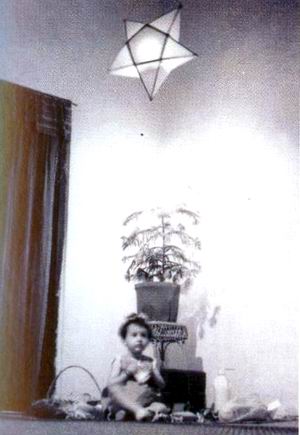
Gauri Pinto at the age of two on 25 December 1939 at the Little House. The star made by Nishtha is visible here.
After that my mother would celebrate Christmas every year until we shifted to the Red House, which is located opposite the present main Ashram library. During the Second World War children of the devotees from Bengal and other states started coming to the Ashram. After the school was inaugurated in December 1943, the Mother asked my mother to arrange a Christmas get-together for all the school children and to give each one a present. Thus Christmas festivities in the Ashram started in 1944, in our Red House. We had a big garden and a lawn where the celebrations were held. My mother and her helpers at Golconde, Mani-ben, Pushpa, Lilou, Kusum-ben, Kumud, Mridula etc. (who were one group) worked hard the previous night to organise, arrange and decorate the place. On Christmas day games were organised which the children enjoyed. There was also singing of songs and distribution of presents to the children. We have photographs of all the children who participated that day. They were the first batch of Ashram children, they were 34 (or 39) of them. From that day onwards the Christmas tradition continues till date. Christmas festivities were held in the Red House in 1944 and 1945. After the celebrations, the children went to the Ashram to greet the Mother. Subsequently the owners wanted the house back and so Mother found Fenêtres (next to Senteurs) for us and we shifted there. At that time Fenêtres too was a rented house. The Christmas of 1946 was celebrated there. Pranab-da had joined the Physical Education Department and he too was invited. He liked the Christmas function and the arrangements so much that he asked the Mother if in the future we could have Christmas celebrations for everybody in the Ashram. So from the next year Christmas was celebrated in the Playground, as it was a far larger place.
Christmas in the Ashram
Christmas in the Playground started in 1947. A traditional Christmas tree in a garden-pot would be placed on the eastern side near the boundary wall of the Playground and a large area around it would be cordoned off. We used to decorate this area with balloons and colourful festoons. A few presents for the children were hung on the tree and the rest were arranged on the floor around it. We used to go to the Playground early in the morning to begin our decoration work.
The Mother used to come to the Playground after her game of tennis. She would take her seat near the tree. After a short programme of music the Mother would distribute presents and cake to all the children. Other than the children all those who were present would also receive gifts and cake from the Mother. My father, Udar Pinto, would dress up as Father Christmas in the traditional red costume, wearing a long snowy beard and would cheer up all the children by tinkling a bell and wishing them “Merry Christmas”.
After the first event, the Mother decided that presents should be given to everyone in the Ashram. We had the festivities in the Playground from 1947 to 1957. At times, due to the north-east December breeze, it got very windy. It then became very difficult to do the decorations as the balloons and other things used to fly all over the place. On the odd instance it rained and we had to rush into one of the adjoining school classrooms — till 1952 our school classes were held in the Playground. There are photos of the Mother giving presents to us children in these classrooms. The Christmas gifts were always distributed by the Mother.
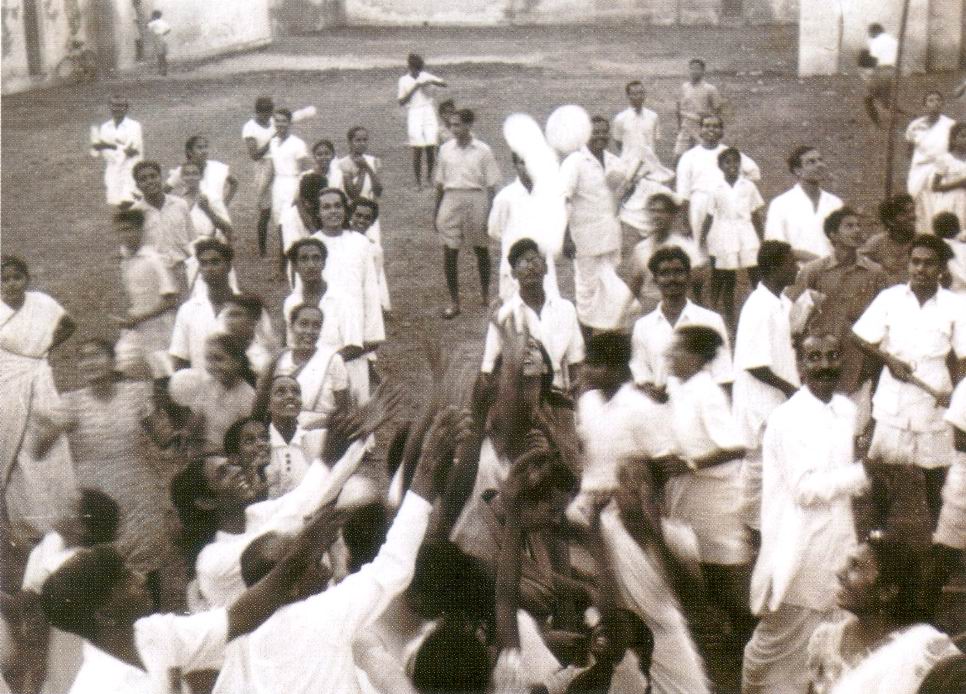
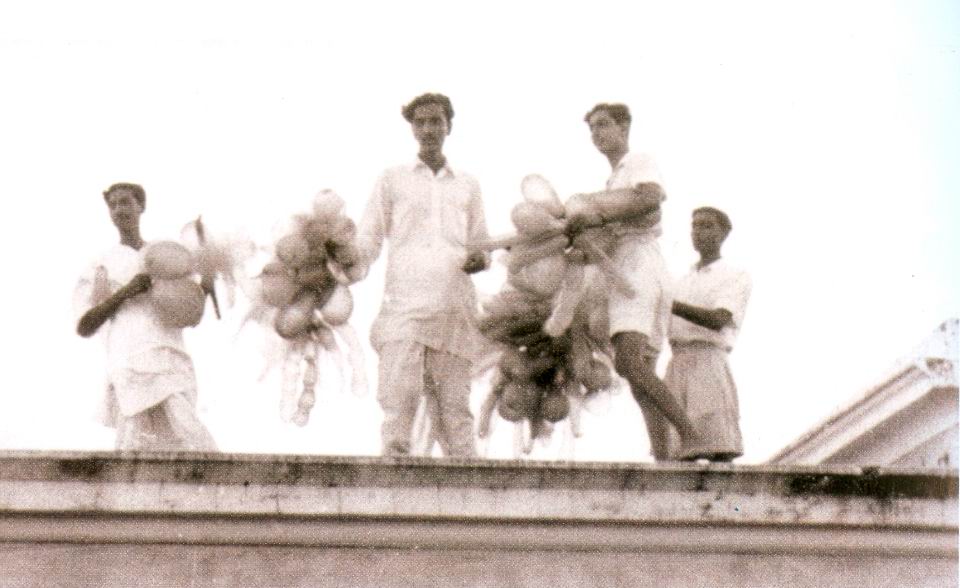
Christmas of 1947 in the Playground. From the Dortoir terrace Robi Gupta, Arun Ganguly, Abhay Singh Nahar and Jayanti-bhai are seen throwing balloons.
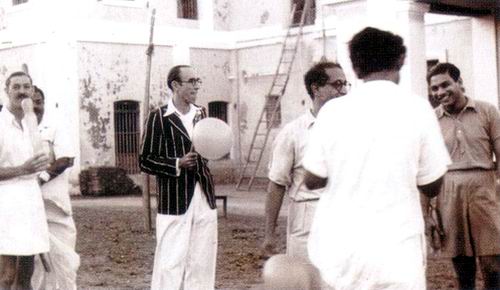
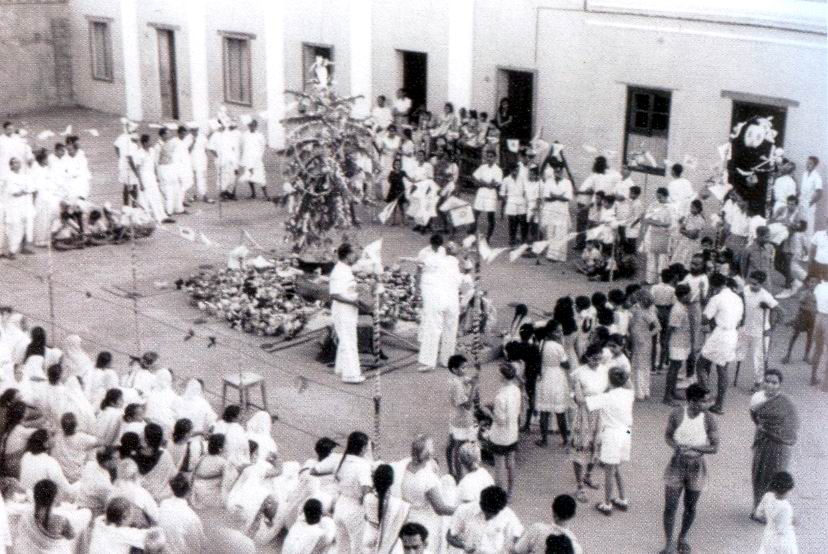
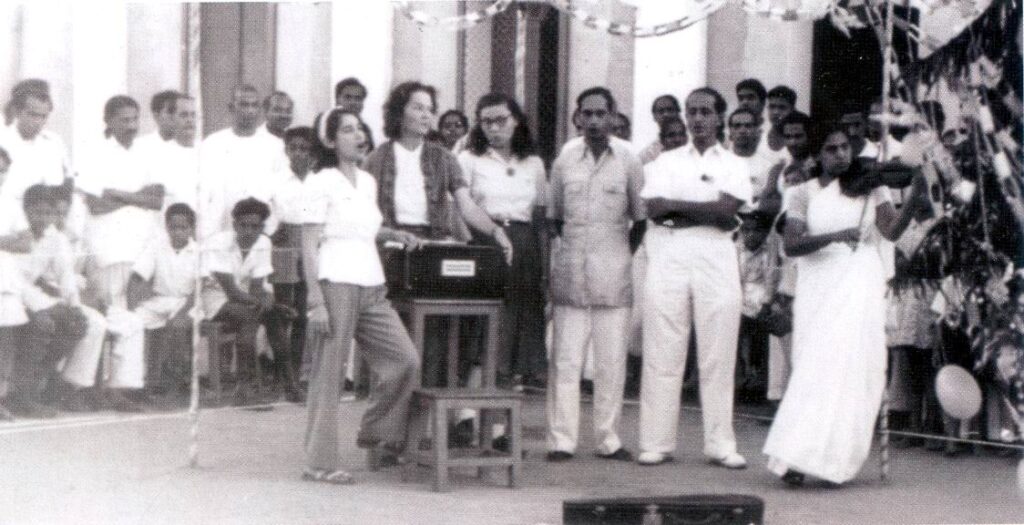
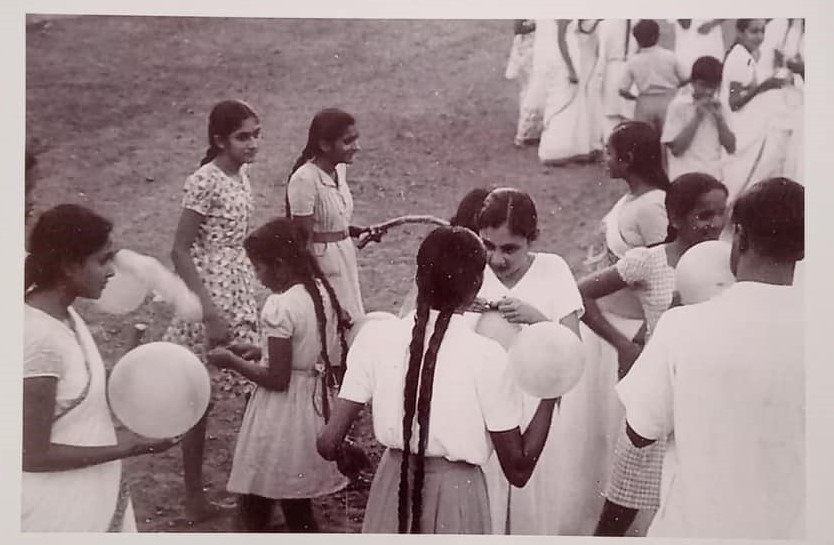
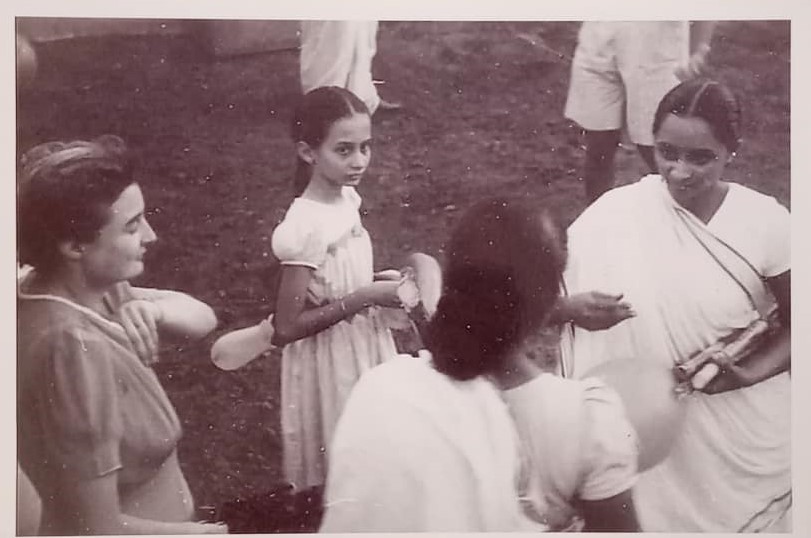
Gauri Pinto with her mother, Mona.
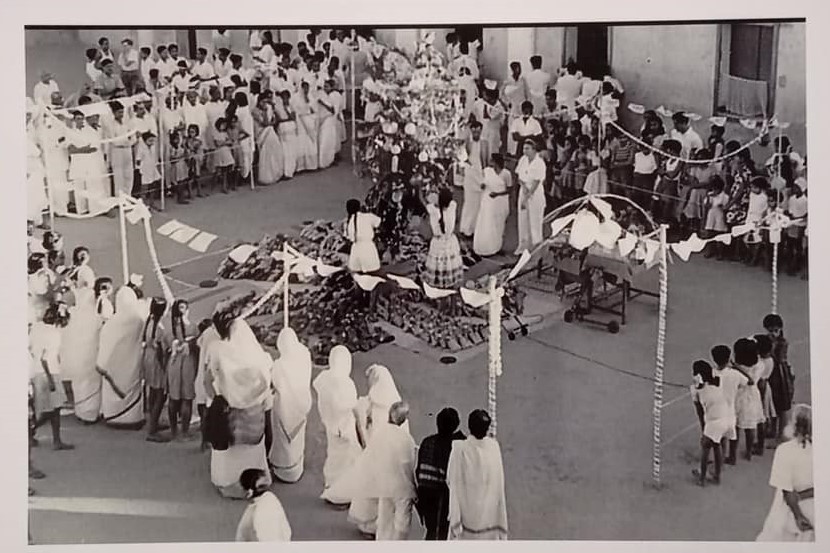
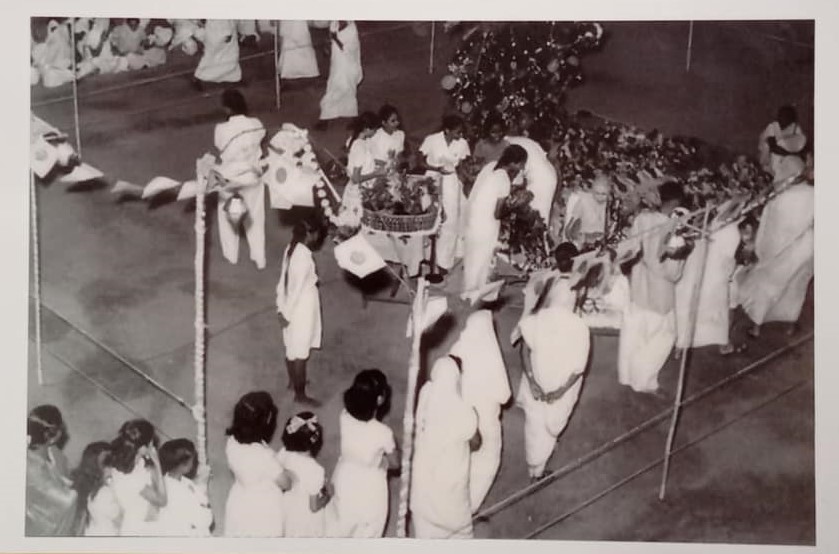
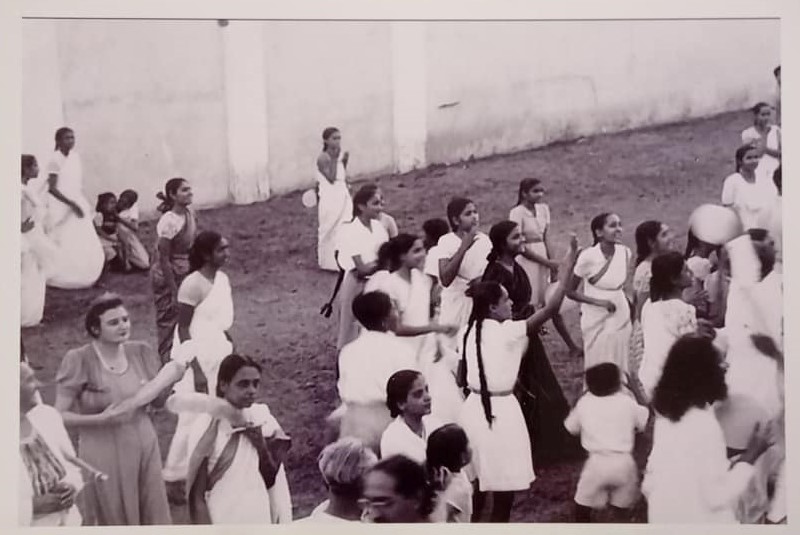

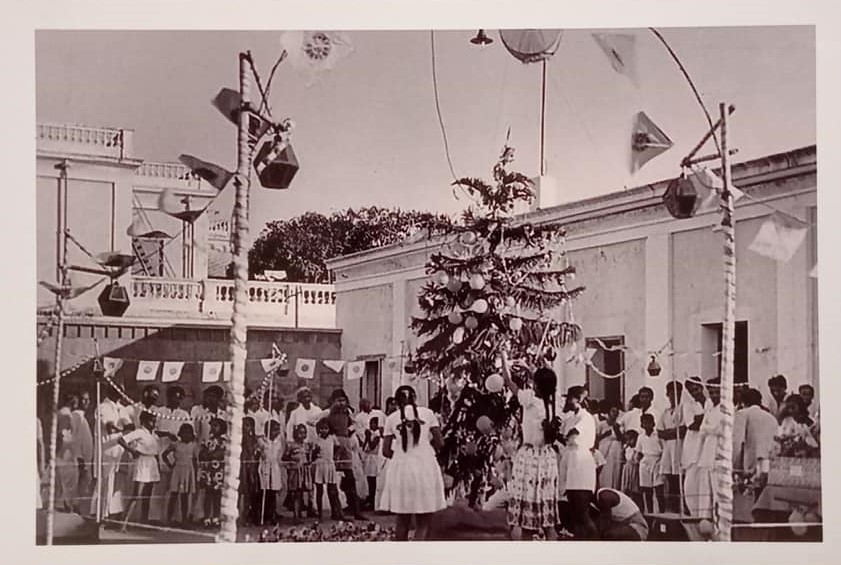
There is also a photo of a choir singing to the Mother at the Playground on the occasion of Christmas in 1949. There was a lady called Marie Amélie who visited the Ashram and taught singing in the Western classical style. She had formed a choir consisting of students and Ashramites. She conducted the choir in front of the Mother at Noël of 1952 and 1953.
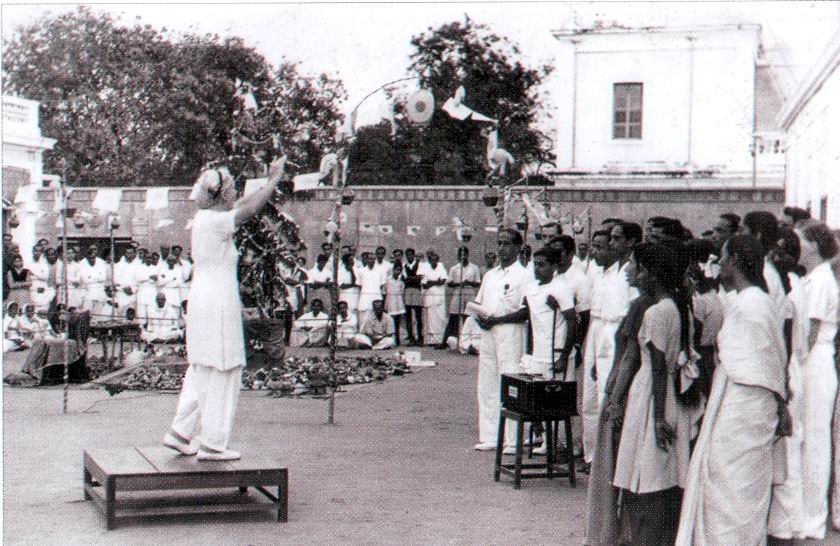
Marie Amélie
There is also the instance of Christmas Eve 1968 where my father, Maggi, Constance and Kusum-ben embarked on a mission to sing Christmas carols to the Mother. So in the middle of the night they, with my father’s accompaniment on the harmonica, sang Silent Night in an empty street under the Mother’s window on Rue St. Gilles.
There is also a photo of Alys with Pavitra-da at the Playground celebrating the Christmas of 1947, just months after our independence. Alys was French and she was very sweet and gentle. My Mother was very fond of Alys. She said that Alys was the sweetest lady she had ever met. We stayed with Alys and her husband Ali (son of Sir Akbar Hydari) in Hyderabad.
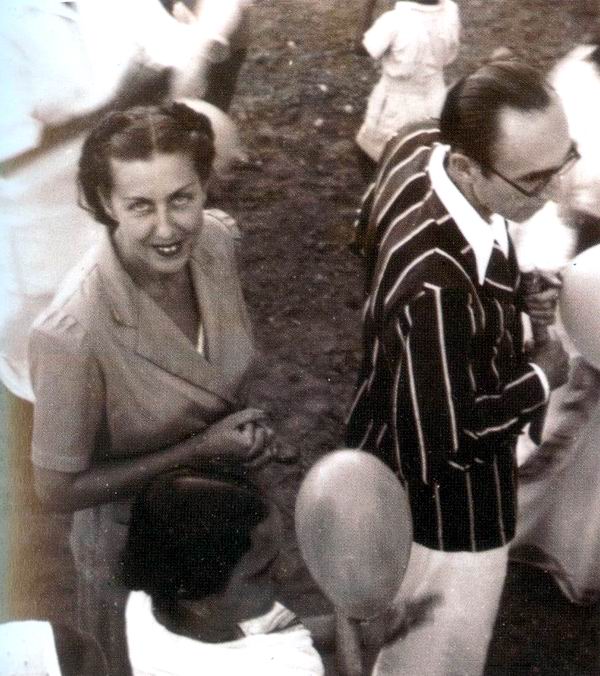
Alys with Pavitra
Sometime in 1956 the Theatre site was acquired. It was inaugurated in 1958, on Mother’s 80th birthday. Since it had a roof and thus protected us from the rain and the wind the Theatre became the venue for Ashram Christmas celebrations from 1958 onwards.
I recall a Noël story that occurred in the Theatre where a glass of Power syrup was given to us all as Mother’s prasad. One of my father’s commercial undertakings was called “Honesty Engineers and Contractors”. A close Gujarati friend of my father’s worked there. He knew Ayurveda and made a soft drink called “Sodalicious” which was sold in the market. My mother had given it the name and I designed the label. For health reasons Mother had told my father to use sugar and not saccharin. On the Noël of 1960 or 1961, Sodalicious was served to all who came to the Theatre. We have photos of Mother going to the stall with Pavitra-da, my father and others to taste the first drink. After Mother sipped the drink it was poured into a large vessel that contained Sodalicious for us all and then individually offered to each of us as prasad.
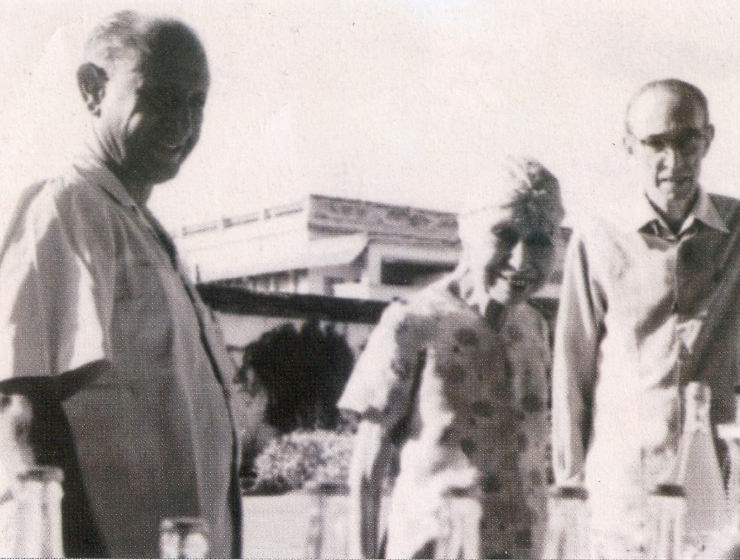
The Mother at Sodalicious booth with Udar Pinto and Pavitra on 25 December 1961
From 9th December, 1958, the Mother withdrew from all external participation in the physical education programmes. Since then and up to February 1962, the Mother came to the Playground only on Darshan Days. In addition she would go to the Sports Ground for the rehearsal of the 2nd December programme. She also made it a point to visit the Theatre to distribute the gifts on Christmas. The Christmas of 1961 was her last visit to the Theatre where she came only for a short while. After seeing the decorations, she distributed gift-packets to a few people and departed. Since then my mother, on the instructions of the Mother, distributed the presents each year.
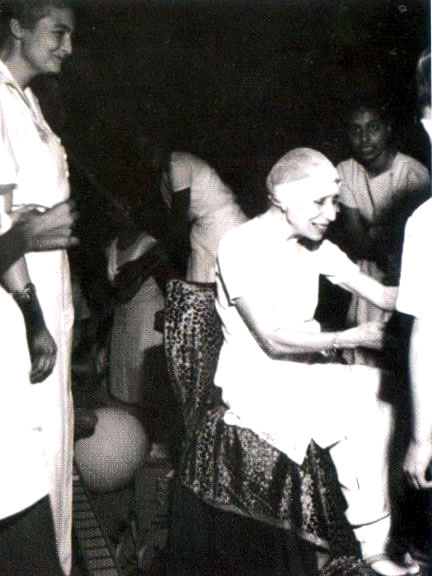
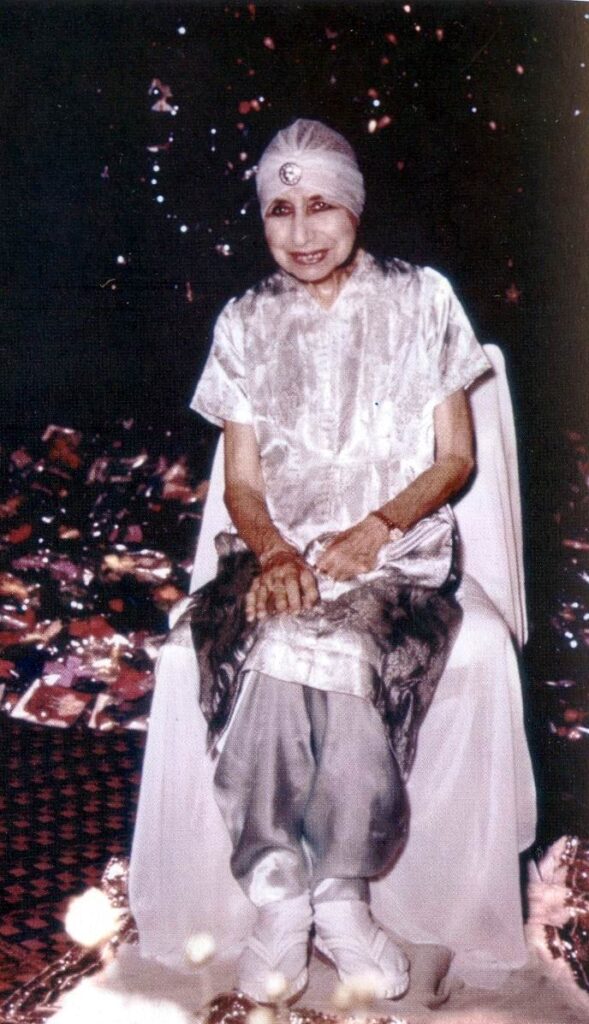
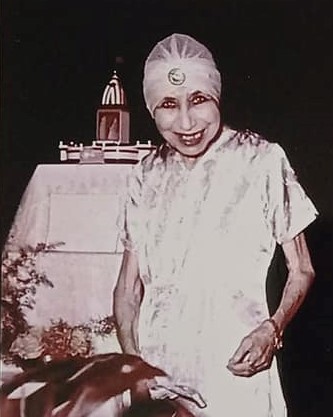
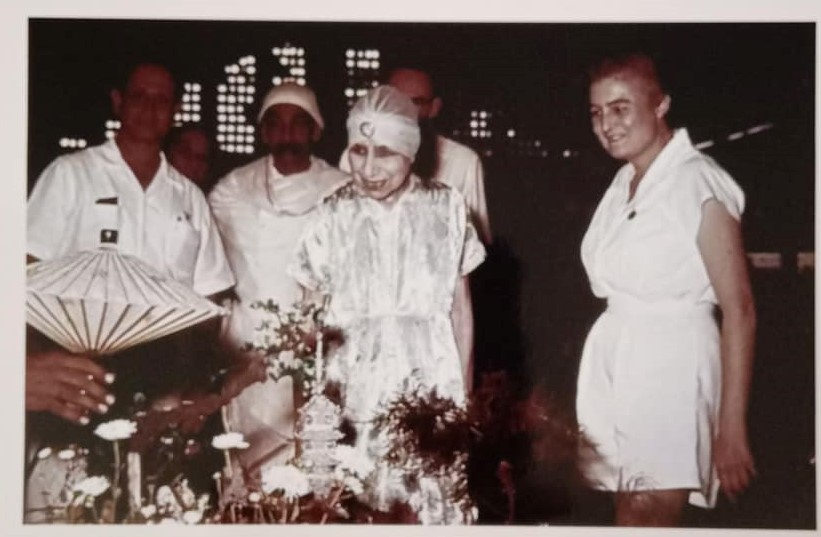
The Mother with Udar Pinto, Nolini Kanta Gupta, Pavitra and Mona Pinto at the Ashram Theatre on Christmas.
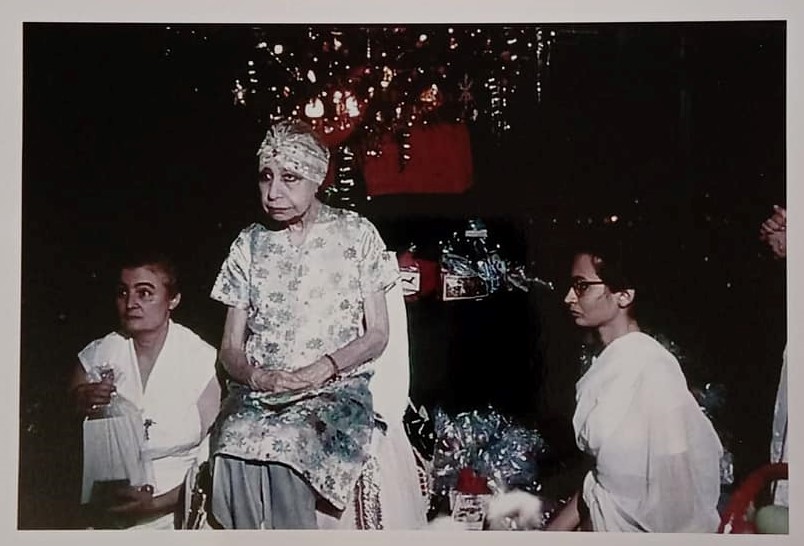
The Mother with Mona Pinto and Gauri Pinto on 25 December 1961
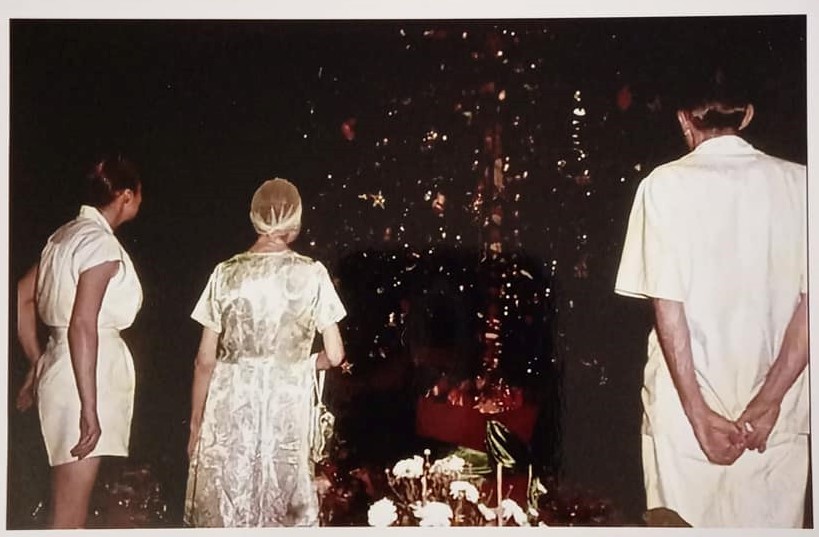
The Mother with Mona Pinto and Pavitra
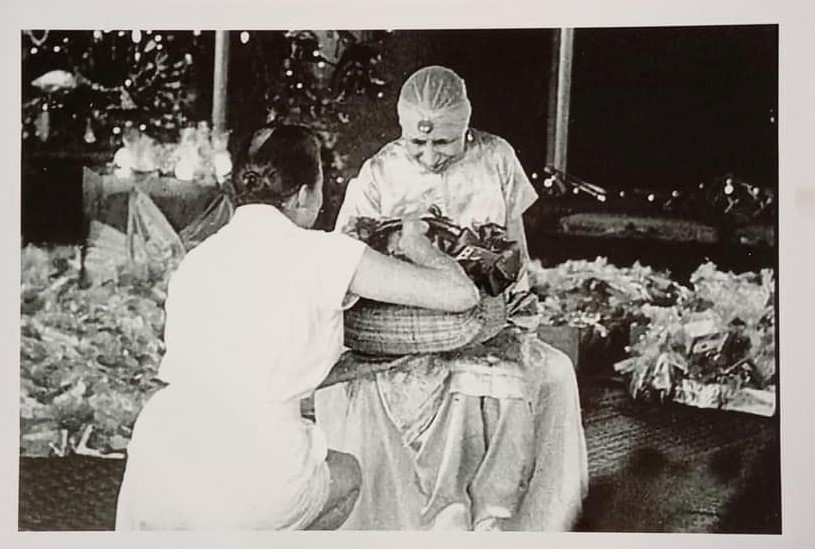
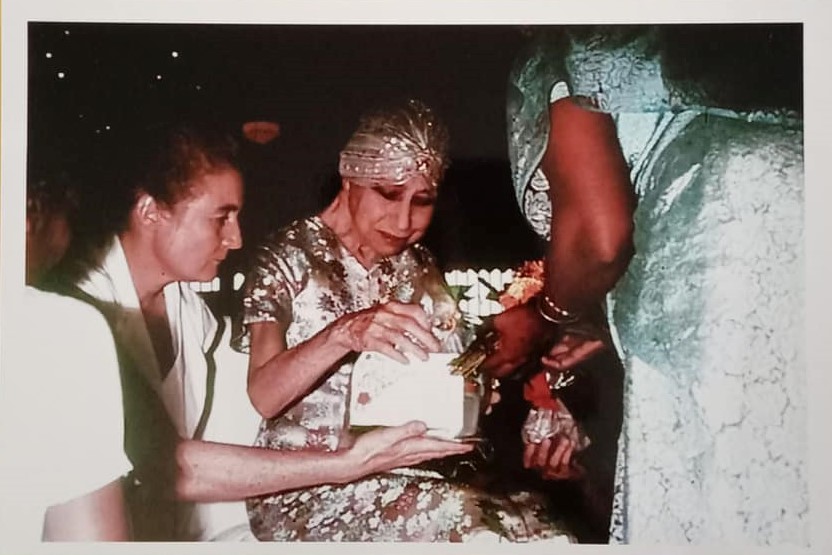
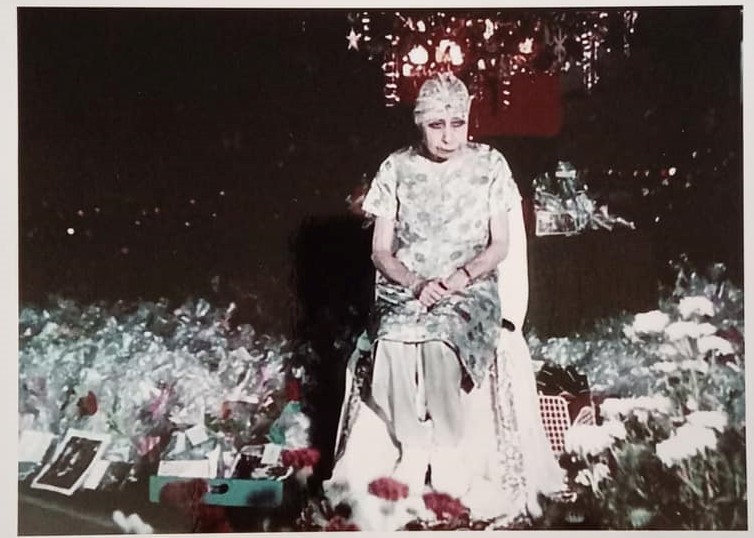
About the Christmas celebrations, a sadhak, Narayan Prasad, wrote in 1964:
‘Similar are the circumstances which led to the celebration of the Christmas Festival, observed here as the rebirth of Light. When there were only about a dozen children in the Ashram, an English Sadhika would invite them to her residence, entertain them and give them some toys. In those days the Mother used to appear on the roof-terrace of the Ashram between 11 and 12 in the morning. The excited children, merrily singing and dancing, would go for her darshan with their red, blue or green paper caps on. As their number increased the festival began to be observed at the Playground in the traditional way with an Xmas tree decorated by the children themselves. Sometimes balloons used to be flown from the roofs. The Mother used to distribute cakes and toys in plastic bags to the young and the old alike. Since 1953 a few bags have in them diaries with the words of Sri Aurobindo and the Mother on each page. For the last two years the Sadhika who initiated this festival has been distributing the plastic bags. Last year it was celebrated at the Theatre, where soft drinks manufactured by the Ashram soda fountain were given to everyone.’ [Narayan Prasad, ‘ Sri Aurobindo Ashram: Ashram Festivals’, Mother India, June 1960, pp. 43-44.]
Janina had a most interesting experience with the Mother at Christmas. About the last Christmas celebration at the Playground in 1957 she wrote:
‘So I wanted to tell you that on Christmas day She just sat in an armchair under the Christmas tree in the playground and not only we, the sadhaks, but other people too could come and get some sweets from Her, which, of course, meant the contact with Grace. We, the sadhaks got more (I got a kind of diary with Her words), and when She gave it to me and looked at me, I just became again a different being. I even did not know how I passed farther and I stood for a time in a corner of the playground filled with something that cannot be described.’ [Janina Stroka, ‘A Captive of Her Love’, Mother India, October 2012, p. 837]
Janina also noted: “On Christmas day, She flooded me with a vibration of such sweet Love that I did not know how I could possibly bear it.” [Ibid., November 2012, p. 914]
The Festival of Light
Long before the birth of Jesus Christ, Christmas was celebrated as the Festival of Light. It was an old tradition. Later, after Christ’s birth and the ensuing establishment of Christianity, the festival became part of the Christian religion. Once in a Wednesday class in 1950, a few days prior to Christmas, the Mother explained to us the origin and the significance of the Festival of Light. She said that in the ancient times some wise men, noticed that at the end of the year, the days were getting shorter and the dark nights becoming longer. They got concerned that the increasing darkness might soon engulf the world and cause great suffering to mankind. So they sat around a fire and meditated and prayed, aspiring for the return of the light. Mercifully the days and daylight hours gradually started to become longer and the dark nights got shorter. Since then this event was celebrated as the return of light in Ancient Egypt.
When a disciple said that the shortest day of the year corresponds to the greatest declination of the sun to the south, about the 21st of December and then the sun again mounts to the north, the Mother commented:
‘That is why the 25th of December was a festival of Light long before Jesus Christ. This festival was in vogue long before Christianity; it originated in Egypt and very probably the birthday of Christ was fixed on the same day as that of the return of the Light.’ [Collected Works of the Mother, Volume 4, p. 6, second edition]
Indeed, the day is symbolic, as we see from the Mother’s Christmas message in 1968:
‘Let the light dawn in your consciousness.’ [Collected Works of the Mother, Volume 15, p. 197]
And earlier on 24th December, 1954, the Mother wrote:
‘A new light shall break upon earth, a light of Truth and Harmony.’ [Ibid., p. 93]
And a report of 1966 from my father, Udar Pinto, stated:
‘On Christmas Day the Mother told me that on every Christmas there is a descent of Peace on the world, but that for this Christmas there was a particularly strong descent of the Peace — very powerful yet extremely lovely. This was perhaps because the world, at this moment, is in such a chaotic state that the Peace has become so very necessary. ‘(27-12-1966) [The Mother on Christmas, Mother India, December 1967, p. 672]
Partaking of Lunch with the Mother
As a young child I used to take my lunch with my uncle, Wilfy. But I wasn’t eating properly and became a sickly child. My mother got concerned about my health and she consulted the Mother. The Mother told my mother that she will teach me how to eat and asked her to bring me upstairs to have lunch with her. It was extremely benevolent of her since she already had hundreds of tasks to do. So my mother, my father and I would join the Mother and Pranab-da for lunch every day in the boudoir. [The boudoir was the Mother’s private sitting room where she would dress, take her meals, etc. It has beautiful paintings of fishes and sea life on its cupboard doors.]When we went there she showed me a dragon painted on a cupboard doorand told me that every time that I come in the morning, I should greet the dragon with a “Bonjour”. I must have been about ten years old then and our lunch with the Mother continued till I was thirteen. The Mother used to serve us the dishes. And when Ali and Alys would visit the Ashram they used to join us for lunch. After Sri Aurobindo’s passing in 1950 Mother stopped having her meal with us, she used to eat alone with Pranab-da. Our lunch, though, continued to be served in the boudoir. After 1950, Gautam Chawalla, who used to work upstairs in Mother’s rooms, joined us for lunch. This continued for many years. We used to go to the boudoir for lunch every day. Once Mother started a facility for someone she wouldn’t stop it. Even after she left her body Dyuman-bhai never discontinued the service and we would get food from Mother’s kitchen. Gautam Chawalla and I used to eat in the boudoir.
Does Father Christmas (Santa Claus) Exist?
One day on Christmas Eve, somebody asked the Mother a question at lunch. The question was: “Does Father Christmas exist?” The Mother replied that one cannot imagine anything that doesn’t already exist on some plane or the other. It exists on a plane. Maybe not in the physical plane but on some plane it exists, otherwise you cannot imagine it. [“You cannot imagine anything which doesn’t exist in the universe! It is impossible to imagine something that doesn’t exist somewhere.” – The Mother (Collected Works of the Mother, Volume 9, p. 379)] Then she said we would have a midnight Christmas dinner tonight and we will invite Father Christmas (Santa Claus). She then wrote in red ink on a slip of paper inviting Father Christmas for our midnight feast. I don’t exactly remember what she wrote but it was an invitation to Father Christmas for dinner with her upstairs at midnight. And four of us, my mother, my father, Pranab-da and I were the other invitees.
We now had to send this invitation to Father Christmas. Since Harpagon used to process steel, cast metal fittings etc. in their workshop they had a furnace. That day my father told Panu-da to clean out the furnace. In the afternoon, on the way to the Tennis Ground, Mother stopped over at Harpagon. My friend Lucy and I were standing there when the Mother arrived. All those who accompanied the Mother for tennis were also there, Amiyo-da, Pranab-da and others. My father took her to the furnace. The invitation that Mother had addressed to Father Christmas had been torn into small pieces and put in an envelope. The Mother put those pieces of paper in the furnace and phoosh all went up into the air, skywards.
Father Christmas and the Midnight Feast
The Mother wanted that the dinner with Father Christmas should be special, a midnight feast. And so arrangements had to be made. Dyuman-bhai was very happy to hear about the upcoming feast and went about organising it. I was naturally very excited at the prospect of the Christmas midnight feast, I had never heard of it before. That evening my mother, who was quite strict, warned me that if I did not sleep early, she would not wake me up for the midnight feast. That prompted me to fall asleep and rather fast. Later when she woke me up, I had my bath and got ready. Then my father, my mother and I went up to the Mother at midnight.
When we reached Mother’s place it was quite dark. Before entering the boudoir I passed through the salon [The salon was Mother’s bedroom where she would take rest. Sri Aurobindo would also come here to consult the Mother and write letters to the disciples during the night.] which had dim lights but was quite dark. I looked out for Father Christmas but I couldn’t see him. So I searched and searched but couldn’t find him. I looked in every corner but all in vain. I thought the reason I couldn’t meet him was because there might be something lacking in me, but I didn’t tell this to my parents.
In the boudoir the Mother had arranged a table for the feast. The Mother, as usual, sat at her small table. Pranab-da, my father, my mother and I sat around it on the carpet on the floor. The Mother was very kind, she had placed a gift for each of us on our seats. Dyuman-bhai had enthusiastically organised everything to give it an appearance of a joyous occasion. For instance, he procured special sleek wine glasses. And to replicate the colours of wine there was tomato juice, apple juice, orange juice and beetroot juice which were poured into these attractive goblets. Dyuman-bhai had the food and the special dishes prepared in the Mother’s kitchen. He happily served us the drinks and the dishes.
Though I didn’t see Father Christmas we had a lovely feast. But the icing on the cake was the lovely gifts that we got from the Mother. There were exquisite artefacts. I am fascinated by tiny things because I find them cute and adorable. The Mother must have known my taste for she gave me a box with six or seven tiny items which she had brought from Japan. The Mother presented my mother two beautiful Japanese dolls that were very artistic. I later gave these to Sri Smriti, which is the museum that houses some of Mother’s belongings. And my father received a bunch of note pads in a beautiful wooden box. I don’t remember what Pranab-da received.
I think Mother organised this joyous event to prove that Father Christmas does exist. It was a most memorable evening.
Later, on a Christmas day, the Mother wrote the following message to Father Christmas.
‘Père Noël
Je t’évoque aujourd’hui! réponds à notre appel. Viens chargé de tous tes présents merveilleux. Tu es le grand dispensateur des biens de ce monde; tu es l’ami inlassable qui entend toutes les requêtes et y répond généreusement. Donne à chacun la chose matérielle qu’il désire; et quant à moi, donne moi assez, donne moi beaucoup pour que je puisse donner à tous largement.’

The translation in English reads:
‘Father Christmas,
I evoke you today!
Answer our call. Come bearing all your marvellous gifts. You are the great dispenser of worldly possessions; you are the untiring friend who hears every request and grants it generously. Give each one the material object he desires, and as for me, give me enough, give me much so that I may give largely to all.’ [Collected Works of the Mother, Volume 15, p. 198, second edition]
There was a Swiss boy who gave us a letter. I found the letter was so beautiful that I wrote it in a calligraphic style and put it on the Christmas board at the Ashram during Christmas.
Once, in a conversation the Mother told a disciple:
‘Regarding Christmas, I’ll tell you a curious story.
For a while, there was a Muslim girl close to me (not a believer, but her origins were Muslim; in other words, she wasn’t at all Christian) who had a special fondness for Santa Claus! She had seen pictures of him, read some books, etc. Then one year while she was here, she got it into her head that Santa Claus had to bring me something. “He has to bring you something for Christmas,” she told me.
“Try,” I replied.
I don’t know what all she did, but she prayed to him to bring me money. She fixed a certain sum. And on Christmas Eve, exactly this sum was given to me! And it was a large sum, several thousand rupees. Exactly the amount she had specified. And it came on that very day in quite an unexpected way.
I found it very interesting.’ [The Mother’s conversation with a disciple on 20 December 1960]
Christmas Presents and Decorations
When we started celebrating Christmas in the early forties, the Ashram did not have much money. The Mother used to send lots of Christmas presents for the children from her personal collection. In those days nobody bought things for Christmas, we would utilise whatever Mother gave us. Also the girls who worked with my mother at Golconde made caps and other small gift items for Christmas. All the children would get a fancy cap to wear at the Christmas party. Mani-ben was very good at making things, she was very skilful. Laxmi, Chiman-bhai’s sister, was also very talented; she made beautiful decorations for Christmas. The Golconde girls too did the Christmas decorations.
We also had to be resourceful in re-cycling things that could serve as Christmas gifts. For instance after Mother finished her tennis game the tennis balls were later used by other tennis players. Afterwards, when the balls became completely bald and unusable for tennis, they were dyed in bright colours of red, blue, green etc. These were given as Christmas toys to the children. Harpagon would also contribute to the Christmas gift kitty; they would make spinning tops, possibly from the left-over wood. In another instance an Ashramite sought permission from the Mother to borrow the book The Puppet Theatre by Jan Bussell for making hand-puppets as gifts to the children for Christmas. The Mother’s instructive reply read, “Yes, on loan and with care.” [Collected Works of the Mother, Volume 15, p. 272, second edition] Later Manoranjan-da too would also go to Madras and buy little plastic toys.
A student at one of the Ashram boardings recalls: “We remember how happy we were to find a present on top of our mosquito nets on the morning of 25th December and how Udar would come in his red Father Christmas costume and a big white beard, ringing a bell.” [Udar—one of Mother’s Children, p. 79]
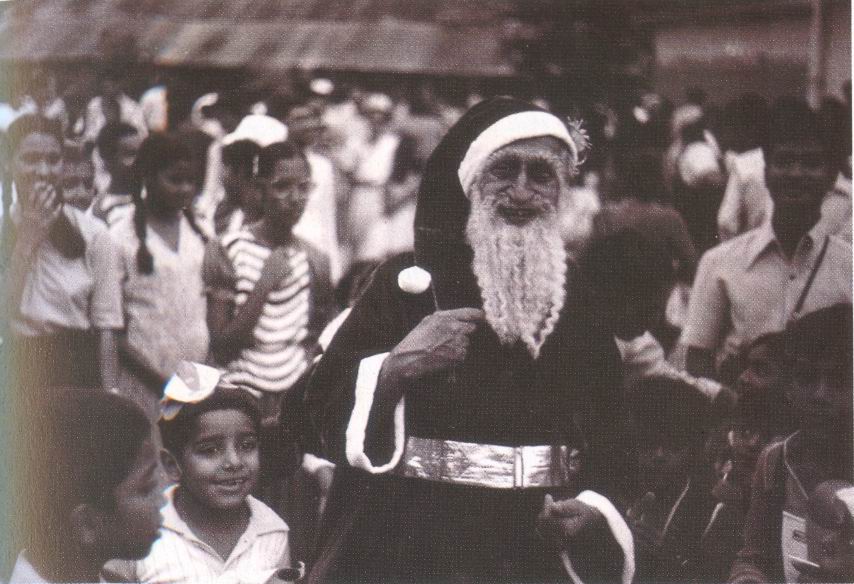
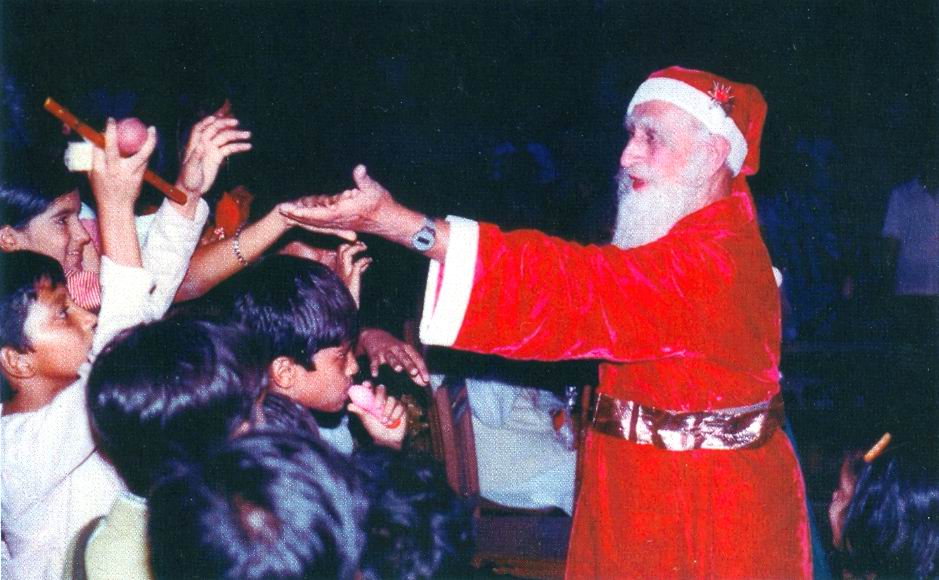
Udar Pinto dressed as Santa Claus
On Christmas day Dyuman-bhai would bring our fruit basket and we would give him a trumpet as a Christmas present. He would play the trumpet all the way back from Red House to the Ashram. And so every Christmas, till he passed away, we would present him a trumpet. The trumpet became a kind of symbol for Dyuman-bhai. I used to make a cake for Christmas and go to his place to offer him some. He loved the cake and would show me his trumpet and triumphantly say, “See it is hanging there.”
During one Christmas, the Mother, after having finished distributing all the presents, asked, “Where is my present?” My mother was so embarrassed. So the next Christmas they tried to replicate a Christmas cake which was shaped like a pie. Mani-ben created a pie made of paper which comprised several compartments, each with a tiny gift inside it. Each compartment had a string or ribbon attached to it and when one pulled it the paper tore and a gift popped out. My father, dressed up as a chef, went to the Mother and presented it to her. Mother initially didn’t like it as she thought if one pulled these strings it would make a noise. But when she saw its noiseless mechanism she was very happy. In the photographs that were then taken one can see her expression change from not so happy to happy and to very happy. And in one photo one can see Pranab-da and my mother laughing. Mother truly enjoyed this incident and took the paper pie-present home.
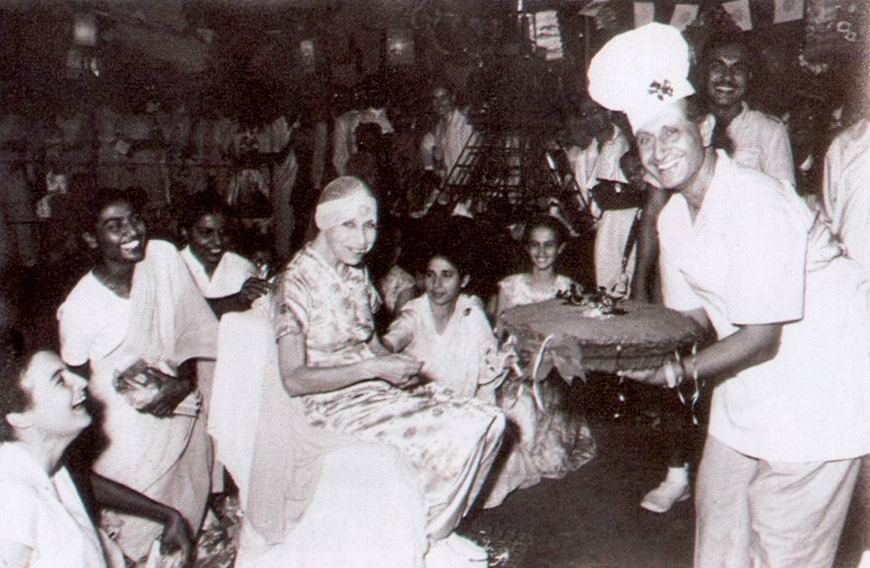
Udar bringing the Christmas pie to the Mother in the Playground. Also seen in this photograph: Mona Pinto, Pushpa Patel, Lilou Patel, Siloo, Gauri Pinto, Pranab Kumar Bhattacharya
During the early decades the children, despite our modest means, were quite happy receiving Christmas presents. These days, however, things are different, the devotees are better off so their children, especially the older ones, don’t find our presents as exciting as the earlier children did. But we try our best to improvise.
Over the past several years some persons have been offering gifts like toys, stationery, chocolate, T’shirts, tops etc. for the Ashram Christmas celebration. Over several months we collect, sort and store these. From these we make Christmas packages which contain an assortment of these items. For each age-group the contents of the packet vary. The packing of the hundreds of presents for the students and the Ashramites takes several days and we have a team who do it. All the students receive a largish Christmas packet and there is an air of excitement for them when they open their gift packets.
The organisation of the Christmas function is a big project and most people in the Ashram — students, ex-students, Ashramites and voluntary workers — attend it. There is a lot of work involved in its organisation. The Christmas tree, cakes, presents, boxes etc. have all to be prepared over several weeks. On the gala day they have to be loaded onto a lorry and transported to the Theatre and unloaded there. The Christmas tree has to be decorated and all the presents and boxes arranged. Then on 26th the lorry will return to the Theatre and we have to load the tree, boxes, leftover cakes and presents back onto the lorry and unload it at Golconde. In the basement of Golconde we have a Christmas room where we store the Christmas tree, the presentsand the decorations.
Every December I make the board for Christmas that is displayed in the Ashram. We collect Christmas cards and I then arrange them and paste them on a board. Tehmi-ben and Jhumur would help with the quotes under the cards. I would also do calligraphy to further embellish the board. This work does take time. The theme on the Christmas board could be Father Christmas, the Christmas fir tree or landscapes. But there are variations: for instance, one year it was on the Shepherd and on another it was the Reindeer which is said to pull the sleigh through the night sky to help Father Christmas distribute the gifts. On another instance it was animals like cats or lions etc. Or it is the Three Kings from the East along with the star from Bethlehem.
Christmas Cake
I think the Christmas cake is something everybody appreciates, especially the students. The Mother was particular that one must have cake during Christmas. All children were given a small, round, chocolate-coated cake on Christmas. Soon after, all Ashramites too were included. It was, I think, during the Indo-China war in 1962 that Dyuman-bhai mentioned to the Mother that we didn’t have icing for the cake. The Mother told him that the Christmas cake must have icing. She went to her cupboard, took out some money and gave it to Dyuman-bhai so that these popular eggless cakes were as good as usual.
I will tell you a story about the Christmas cake. We used to keep the Christmas cakes in the store room which had ventilators. On one particular Christmas, some of the Ashram boys got in through the ventilators and stole quite a few cakes. But it was so quietly done that we didn’t know about the theft. On Christmas day the Mother was distributing the cakes but towards the end the shortage was discovered. Since the queue was still there we were in a panic. My mother was puzzled as we always meticulously count the cakes. We then started taking down the decorations from the Christmas tree and started giving these to the Mother to distribute.
By then we realised that the cakes had been stolen. The Mother was very annoyed. As Mona Sarkar was the group captain, the responsibility of the theft fell on his shoulders. The Mother told him that everything is given to the group members, they don’t have to steal. I don’t think Mona stole but he took the whole blame because it was his group. He took Mother’s anger on himself because he was the captain of the group. He didn’t pass on the offence to those who were actually guilty. It was very brave and noble of him.
Christmas Baskets
In the early days, till Mother’s passing, Christmas baskets were given to a select few. Christmas baskets were cane baskets containing gifts, specially prepared for foreigners, most of whom were from Europe and the U.S. A day before Christmas the Mother would arrange the baskets along the corridor. The corridor, whose access is the staircase next to Nirod-da’s room, is along the adjoining rooms of Mother’s salon, boudoir, washing room and Pavitra da’s room. From the Samadhi one can seethe windows of the corridor running east to west. When I used to go up for my lunch with my parents, I used to see these cane baskets all smartly arranged in a straight line. The gifts were neatly packed in these baskets. I don’t know why the Mother took so much effort and what was the criteria for selecting the beneficiaries. It was possibly because their home or homelands were far away.
These Christmas gifts was not solely a Christian thing, for instance the Chinese artist Hu Tsu would always get a gift. I think it was for people who were away from home. For instance, after the Chinese invasion of Tibet, some Tibetan guests came here in December. All the 17 Tibetan guests got Christmas baskets.
The Mother was aware of each one’s taste and would carefully choose the gifts. For Hu Tsu, I remember, the Mother used to specially keep tea for him. My mother used to be with the Mother, helping her arrange all the things. One can imagine the amount of time and care the Mother took for each. We have a list of the people who received the Christmas baskets in 1969 — there were almost 200 people, including about 75 Aurovilians. The Mother, out of her graciousness, even sent baskets to some 16 Italian visitors and some American students who were staying at Parc-à-Charbon (presently, Park Guest House).
About the Mother’s care in arranging the baskets during Christmas, Nirodbaran mentions: “On its eve she would sit down in a chair or on a low stool and with the help of some sadhikas arrange each basket, consider each individual’s taste, necessity, fancy, giving cheese, chocolate, fruits, etc., etc. while time would stop flowing for her. We were waiting in Sri Aurobindo’s room for his meal, but we knew and would joke with one another that the Mother was in her element, for though Divine, her human motherly instinct could not be forgotten.” [Nirodbaran, Twelve Years with Sri Aurobindo, pp. 101-102, 2000]
On Christmas day the whole corridor upstairs was lined with gift baskets. Then my father and Gautam Chawalla would go in the jeep and distribute the gifts to the concerned people.
About the beneficiaries of the Christmas baskets Nirodbaran has noted: “During Christmas, it was her custom to send ‘baskets’ to the European and American inmates, out of consideration for their national sentiments, I suppose.” [Ibid., p. 101]
The Mother was once asked, “…why is a distinction made here between Europeans and Indians on Christmas Day?” She replied,
‘As far as I know, everyone in the Ashram is allowed to come to the Christmas tree and the distribution.
The custom of sending special baskets to the Europeans and Americans comes from the fact that in those countries they usually give presents to each other on Christmas Day, instead of on January first. That is all.’ [Collected Works of the Mother, Volume 17, p. 360, second edition]
Mother’s Christmas Messages
From 1959 until 1972 Mother gave messages for Christmas which were pinned on the Ashram notice-board along with a collection of beautiful Christmas cards. Some of the messages that Mother gave are [see Collected Works of the Mother, Volume 15, pp. 195-198]:
- May the New Light illumine your thoughts and your lives, govern your hearts and guide your action. Blessings. (1962)
- Joyeux Noël. Let us celebrate the Light by letting it enter into us. (1963)
- If you want peace upon earth, first establish peace in your heart. If you want union in the world, first unify the different parts of your being. Blessings. (1964)
The significance of Mother’s Christmas message can be gauged when in February 1965 She sent again the Christmas 1964 message. She wrote:
‘The message written for Christmas was blocked for that very purpose. You must utilise it.
If you want peace upon earth, first establish peace in your heart.
If you want union in the world, first unify the different parts of your own being.’
- Bon Noël to all, in Peace and Joy. May this new Christmas be for you the advent of a new light, higher and purer. (1966)
- Union and goodwill upon earth. Behind the rigidity of the outward celebrations there is a living symbol; it is this that we must remember. Peace and goodwill to all. Unless a break is made with the habits and the beliefs of the past, there is little hope of advancing rapidly towards the future (1967)
- Love the Truth.Let the light dawn in your consciousness. Blessings to all. (1968)
- Hail the new light. That it may grow in all hearts. Blessings (1969)
- The time has come for the rule of falsehood to end. In the Truth alone is salvation. (1970)
- We want to show to the world that man can become a true servitor of the Divine. Who will collaborate in all sincerity? (1972)
The Day of Epiphany (Three Kings Day)
6 January is known as the money day in the Ashram. It was the day that the three Kings — referred to as the three wise men, the Magi — from the East followed a guiding star to Bethlehem to pay homage to baby Jesus, who was still in a cradle, and to hail him as a king. They offered him Frankincense, Myrrh and Gold. It is called the day of Epiphany or Three Kings Day. Mother said it was very important, more important than his birth because those Kings accepted his divinity. The Mother has given the significances of the gifts offered by the three Magi to Jesus at the time of his birth:
Gold: wealth of the world and supramental knowledge.
Frankincense: purification of the vital.
Myrrh: immortalisation of the body. (Ibid)
The arrival of the three kings has been depicted in many works of art — “Adoration of the Magi” — including paintings by artists like Leonardo da Vinci, Sandro Botticelli, etc. Joan of Arc, of whom Mother spoke so highly, was believed to be born on the Day of the Epiphany on 6 January, 1412, in the village of Domrémy.
Narayan Prasad in his Life in Sri Aurobindo Ashram writes about the importance of Christmas day and the day of Epiphany:
‘In the year 1933-34, besides the Darshan Days and the 1st of January, no anniversary was celebrated in the Ashram except four other days on which the Mother gave her general blessings with the leaves of a plant named by her “New Birth” or with other flowers of a special significance. These four days were the 29th March, the day of the Mother’s first arrival in Pondicherry (1914); the 4th April, the day of Sri Aurobindo’s arrival (1910); the 25th December, the day of the rebirth of Light; and the 6th January, the festival of Epiphany.’ [Narayan Prasad, Life in Sri Aurobindo Ashram, 2010, p. 142.]
My mother had a money box which served like a piggy bank. It was a simple box made of cardboard with a wooden base, with a slit on the top to drop the coins. It had a picture of Noah’s Ark with animals like the elephant, giraffe, zebra, lion etc. painted on the cardboard. During the Second World War the economic situation was very bad, yet my mother put coins in the money box. She would collect these coins for the whole year and then on 6 January, money day in the Ashram, she would give me this box to go and give it to the Mother. When I would offer the money box to the Mother She would be so happy. She would personally count all the coins herself. And after that She put one or two coins back inside the box and I recall her saying, “these will have babies”, akin to a seed that reproduces. The Mother would return the box the next day. This went on for many years, my mother collecting the coins over the year and I taking the box to the Mother.
I would like to make an observation here. The Mother’s way in accepting gifts and offerings was always very touching. I remember when I was a small child my father had made a bank deposit in my name. When I was a teenager the deposit matured; it was a sum of Rs. 300. My parents gave it to me and told me to give it to Mother. You cannot imagine how gracious and happy Mother was with the offering. She behaved as if I had parted with the Kohinoor diamond. I was quite puzzled because it was not as if I had earned the money. She asked if I was sure that I did not need the money to buy something. I said “No”, but She made me feel so special, even though the money was not a colossal amount. The Mother was always caring and she was so full of love and graciousness. She showed us how to be grateful and gracious when offered something.
There is the incident of a villager or a poor person who sent a money order of one Rupee and told the Mother, “Mother, please buy a mango for yourself.” Now Mother was not fond of mangoes but she called Dyuman-bhai and told him to buy a mango for her. She ate a piece of that mango.
Another episode concerned the Bengali devotees who used to come from Calcutta by train. I think they used to stop at Doraiswamy’s house in Chennai, take rest, and later take the train to Pondicherry. Once, while travelling in the train from Calcutta they were talking about the Mother. There was one villager travelling in the same compartment, listening quietly. To him, their love for the Mother was so obvious and palpable. And when his destination came, he had to disembark. At that time he told these devotees that what he heard about the Mother was so beautiful that he gave one Rupee and requested them to offer it to the Mother. He was a poor man and in those days one Rupee was not a modest amount. When the devotees arrived in Pondicherry and met Mother they gave the one Rupee and told her the background of the story. The Mother then wondered how she could ever repay that man. It was then that the devotees realised the full significance of the offering. Can one imagine the Mother saying such a thing. We learnt the meaning of gratitude from her.
These gestures of love and compassion from the Mother get etched in one’s memory or perhaps in one’s soul. She used to receive everybody so sweetly. Whenever people used to offer her something she would accept it with so much love. There was a lady who handcrafted something, which was not at all beautiful. In fact it was so bad that we children smiled to ourselves. But when she offered it, Mother received it so graciously. At times children made awful drawings and offered them to the Mother. But she accepted everything with such compassion. Recently we have been cleaning Her clothes in her room upstairs and we have discovered many small embroidered handkerchieves which must have been offered by children. Some of these are tiny, yet Mother has preserved them. Everything was precious for her and she kept them all with so much care.
The Mother and Mona
In this concluding section we briefly examine Mona Pinto’s relationship with the Mother. The Mother has called my mother, “Mona, my dear and faithful collaborator.” The Mother loved my mother a lot. Every Christmas the Mother was particular to give her a gift. Even on her birthday Mother used to take care. Gautam Chawalla, who used to work with Mother, mentioned that Mother used to say: “Mona’s birthday is coming what can I give her, what can I give her.”
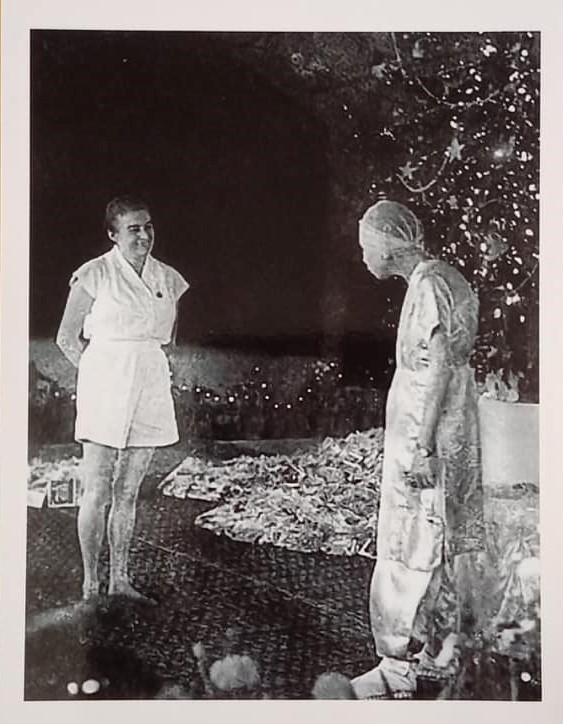
The Mother with Mona Pinto
On Christmas Eve my mother would assist the Mother in arranging the Christmas baskets which were to be sent to the foreigners.
The following day at Christmas she would hand over the gifts packed by us to the Mother whilst she distributed these presents to the children. One Noël evening I was given the honour of passing the cakes to Mother, while on her other side, my mother was passing the bag with the gift. We tie both the gift packet and the cake packet with a colourful paper ribbon. While I was going to pass a cake, I saw that the ribbon had opened up and was hanging. Thinking it might disturb the Mother, I quickly tore off the ribbon. On hearing the sound of the tearing paper the Mother looked down, rather annoyed. So I then knew that I had done something wrong. I should have just left the cake on the tray and given another one. Mother never made hasty actions, even when she was late. She always did things fully conscious, without haste.
After the Christmas in 1961 the Mother was unable to come to the Theatre to distribute the gifts to the children and the devotees. In 1962, the Mother told my mother, “I won’t give anymore, you give.” Since, the Mother was no longer able to attend, my mother suggested that we stop the Christmas celebrations. The Mother then touched my mother’s heart and said, “No, no, no. I am here, inside you. You give it from now on. You give the presents and I am in you.” So my mother had to continue the Christmas celebrations and it is going on till this day. The children remembered my mother as the smiling lady who wished them “Merry Christmas” as she handed them their gifts.
I also remember an instance where my mother wanted to present a Christmas gift to the Mother. When she came to India to marry my father, Udar Pinto, she brought many things from England, for at that time one could bring loads of luggage on the ship. She wanted to present a pretty vase to the Mother and so she spoke to Nolini-da about it. All Nolini-da said was “Vase”, “Mother”, “Offer.” One could speak to him for a long time and he would sweetly utter only a word or two. He was so wise, yet spoke little.
In fact, I have a letter dated 11th September, 1938, that my mother wrote to the Mother. It states:
‘Mother,
I am sending you a flower vase which I brought with me from England. It was at that time the very “latest thing” in vases and it still is. Do you think that Sri Aurobindo could have it for his table?…’
Sri Aurobindo himself replied to the letter saying, “The Mother likes the vase very well — it is new and gives a pleasing effect when flowers are arranged in it.”
Aniruddha Sircar, an English teacher at the Ashram School, writes about Mona:
‘From 1944 when the Mother decided to celebrate Christmas as the Festival of Light, She gave Mona the responsibility of arranging the Christmas Tree and conducting the gift distribution every year. So long as the Mother went to the Theatre, she used to take the beautifully packed gifts from Mona’s hands and herself distribute them to everybody. In the Ashram, just as one could not think of the Golconde without Mona, so too had Christmas and Mona become synonymous.
‘About the significance of Mona’s birthday the Mother once said, “Mona’s birthday is on the eleventh. She was born on the eleventh day of the eleventh month of 1911. Eleven — that is the number of progress . . . She is someone who truly loves to do things well, and wants to do them well and whatever she does, she does lovingly and very well.”
‘What the Mother thought of Mona’s dedicated service is reflected in one of the many birthday cards that the Mother had written to her:
Bonne Fête !
To Mona
Here is one more occasion to tell you physically what I tell you so often when we meet in the night. How much I appreciate the quality of your work and how much I rely on your faithful steadiness. We are very close inside although we meet rarely outside, but my love and blessings are always with you. Mother. (11.11.1963)

Two birthday notes from the Mother to Mona Pinto

Children and others at Red House, Christmas 1945
Front row: 1. ?? 2. Nirakar 3. ?? 4. Jyotindra 5. Bhai 6. Chitra J 7. Purnima 8. Krishna Kumar 9. Namita 10. Bubu 11. Kuku 12. & 13. Two neighbours
Second row: 1. Chum 2. ?? 3. Ranga 4. Chinu 5. ?? 6. Aruna 7. Gauri 8. Sudha S 9. Lucy 10. Birju
Third row: 1. Pavita 2. Arvind Prasad 3. Gopinath 4. Kalu? 5. Parul 6. Jhumur 7. Nirata 8. Usha 9. Prabha 10 ?? 11. Tara 12. Prabir 13. Narendra 14. Arunkumar 15. Anu P 16. Kusum N 17. Chellama
Back row: 1. Norman 2. John L 3. Manu-bhai 4. Kumud 5. Lilou 6. Amita 7. Tanima 8. Pushpa 9. ?? 10. Dhanavanti? 11. ?? 12. Urmila 13. Lata 14. Paru 15. Pran-bhai? 16. Pearson

Children in the Ashram Courtyard, Christmas 1946
Left to Right: 1. Ranga 2. Ambu 3. ?? 4. Pritindra 5. ?? 6. ?? 7. Gopinath 8. Hriday N 9. ?? 10. Shanta 11. Sumantra 12. Ramesh 13. Arunkumar 14. Subodh 15. Ramraj 16. Bhai 17. Arvind Prasad

The Mother listening to a choir conducted by Marie Amelie, Christmas in the Playground, 1952

Christmas decorations and gifts in the Playground, 1954
Courtesy: Mother India, December 2022.
Photographs courtesy: Ms. Gauri Pinto and Overman Foundation Archives.
*
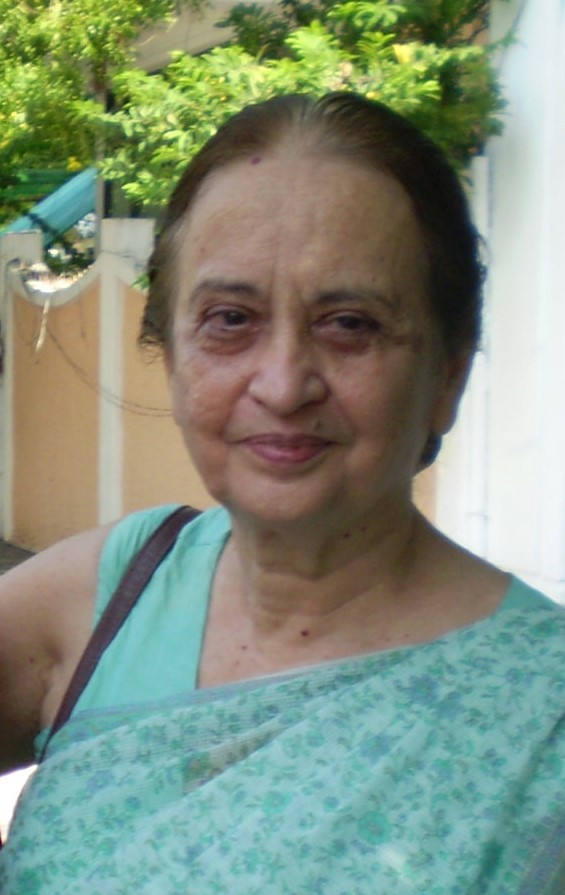
About the Author: Born as Judy Ann Pinto on 16 November 1937 to Udar and Mona Pinto, Gauri Pinto (named by the Mother) practically grew up in the Sri Aurobindo Ashram where she was brought to when she was six weeks old. Being one of the students of the first batch of the Ashram School, she later joined the Sri Aurobindo International Centre of Education as a teacher of English and Drawing and served the institution for over sixty years. Presently, she is in-charge of Golconde, the oldest dormitory of Sri Aurobindo Ashram and also of the Mother’s rooms situated on the first floor of the Ashram main building.
Fantastic recapitulation of that Golden Era, captured so nostalgically, evokes an age long since gone, Do we realize it’s 50 yrs ago Mother left Her body.
This is an excellent post. A word about the beginning of the Festival of Light, from 25 December, fixed as the birthday of Christ also. The Mother speaks of it belonging to an ancient tradition.
In India it has the significance of the bright half of the day of the gods, and all auspicious things happen during this period.
Mahabharata has the famous incidence of Bhishma waiting to leave his body only with the beginning of Uttarayana, the sun from the extreme south starting to move towards the north, north movement, north, uttar, upward, celestial, with the days becoming longer and longer.
Hello, Gauri, quite a thrill to hear you speak of persons, things and happenings that nobody else could do. Fortunately Anurag has worked out the difficult task of turning you into such a convincing story teller who reminds us how truly old is gold. Can we have a little more ?
I got overwhelming joy. The wonderful writing conveyed the sweetness in the context of that time.
.